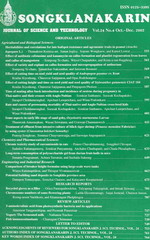ThaiScience
ThaiScience
SONGKLANAKARIN JOURNAL OF SCIENCE & TECHNOLOGY
Volume 43, No. 01, Month JANUARY, Year 2021, Pages 96 - 104
Experimental studies and artificial neural network modeling of hydrogen sulfide removal from wastewater by calcium-modified coconut shell based activated carbon
Omar Abed Habeeb, Bamidele Victor Ayodele, May Ali Alsaffar, Tuan Ab Rashid Bin Tuan Abdullah, Ramesh Kanthasamy, Rosli Bin Mohd. Yunus
Abstract Download PDF
In this study, activated carbon -based adsorbent was prepared from eggshells and coconut shells. The effects of contact time, initial H2S concentration, and the calcium impregnated coconut shell activated carbon (Ca-CSAC) adsorption dosage on the hydrogen sulphide (H2S) removal efficiency and adsorption capacity were investigated. The batch adsorption data obtained from the experimental runs were employed to fit an artificial neural network (ANN) model. An initial optimization was performed to obtain the most suitable number of hidden neurons for training and validation of the ANN. The optimization results show that 16 hidden neurons was the most appropriate choice. The trained ANN was adequately validated and tested with coefficients of determination (R2) of 0.99 and 0.95, respectively. The ANN was found to be a robust tool for modeling of H2S removal efficiency by and adsorption capacity on Ca-CSAC under different process conditions
Keywords
artificial neural network, adsorbent, hydrogen sulfide, coconut shell, modellingSONGKLANAKARIN JOURNAL OF SCIENCE & TECHNOLOGY
Published by : Prince of Songkla University
Contributions welcome at : http://rdo.psu.ac.th
